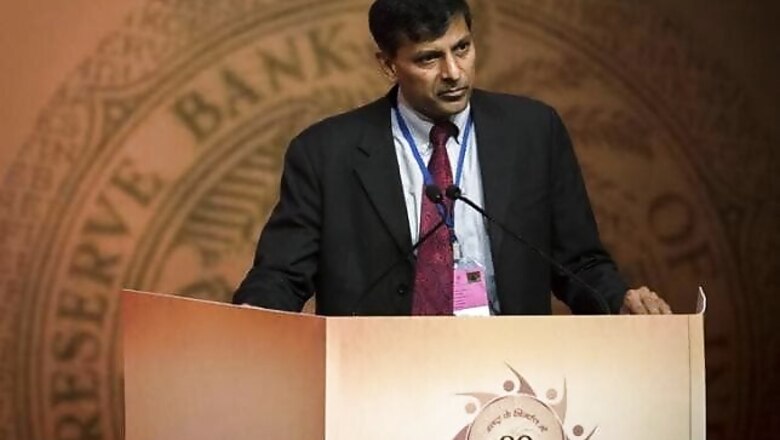
views
Mumbai: Sending out a strong signal to the banks to cut interest rates for consumers, the Reserve Bank of India (RBI) Tuesday brought down the Repo Rate by 25 basis points to 7.25%. The cut is the the third time in 2015, and meets market and government expectations of boosting growth by lowering borrowing cost.
But the apex bank kept the Cash Reserve Ratio unchanged at 4%. With the repo rate reduced, EMIs are likely to come down much to the relief of consumers.
The reverse repo rate stands adjusted to 6.25 per cent, and the marginal standing facility (MSF) rate and the Bank Rate to 8.25 per cent.
Full text: RBI reduces repo rate by 25 basis points, keeps CRR unchanged at 4.0 % in monetary policy review
While announcing the Second Bi-monthly Policy Statement for the year 2015-16, RBI Governor Raghuram Rajan said, "The rate cut is an attempt to boost investment. We have done what we think is 'appropriate' in view of current data."
In its credit policy review, the RBI expects Current Account Deficit (CAD) at 1.5% of Gross Domestic Product (GDP) in the financial year 2015-16. The RBI also expects inflation to start rising to 6% by January 2016.
The stock market however reacted negatively with the BSE Sensex going down by over 400 points after the RBI policy was announced.
Rajan said he expects banks to pass on the policy rate cut to individual and corporate borrowers. "Banks should pass sequence of lending rate cuts," he said, adding that RBI has cut interest rate thrice since January 2015.
Following the downward revision in the repo rate (short-term lending rate), the reverse repo rat (short-term borrowing rate) has got adjusted to 6.25 per cent and Marginal Standing Facility rate as well as Bank rate to 8.25 per cent.
Commenting on macroeconomic conditions, RBI said, the domestic economic activity remains moderate with agriculture being the most disappointing one, following the unseasonal rains and hailstorms in the most part of the country in March.
However, Rajan was quick to add that the risks to inflation identified in April could cloud the picture with below par monsoons forecast for the second successive year. He also called for astute food management to mitigate possible inflationary effects in case of failure of monsoon.
The other possible problem, the governor said, could be continuously firming crude prices amidst considerable volatility, coupled with geo-political risks, which might cloud the inflation forecast.
Given this background, Rajan said, "a conservative strategy would be to wait, especially for more certainty on both the monsoon out-turn as well as the effects of government responses if it (monsoon) turns out to be weak."
"(But) with still weak investment and the need to reduce supply constraints over the medium-term to stay on the proposed dis-inflationary path (to 4% in early 2018), a more appropriate stance is to front-load a rate cut today and then wait for data that clarify uncertainty," Rajan said while explaining the rationale behind the rate cut.
A key reason for the rate reduction is the CSO's downward revision in both the current year forecast to 7.6% from 7.8%. "Reflecting the balance of risks and the downward revision to GVA (gross value added) estimates for 2014-15, the projection for output growth for 2015-16 has been marked down from 7.8% in April to 7.6% with a downward bias to reflect the uncertainties surrounding these various risks," RBI said.
Rajan said strong food policy and management will be important to help keep inflation and inflationary expectations contained over the near term. Furthermore, monetary easing can only create the enabling conditions for a fuller government policy thrust that hinges around a step up in public investment in several areas that can also crowd in private investment. This will be important to relieve supply constraints and aid disinflation over the medium term, he said.
"Banks have started passing through some of past rate cuts into their lending rates, (a precondition he set at the last policy meet on April 7), headline inflation has evolved along the projected path (4.86% in April), the impact of unseasonal rains has been moderate so far, administered price increases remain muted, and the timing of normalisation of US monetary policy seems to have been pushed back," he said.
The global data also points to not so rosy a picture. The global recovery is still slow and getting increasingly differentiated across regions. What is more worrisome is the US numbers where the world's largest economy surprisingly shrank 0.7% in the first quarter, even as its currency has been on record high.
(With inputs from PTI)


















Comments
0 comment